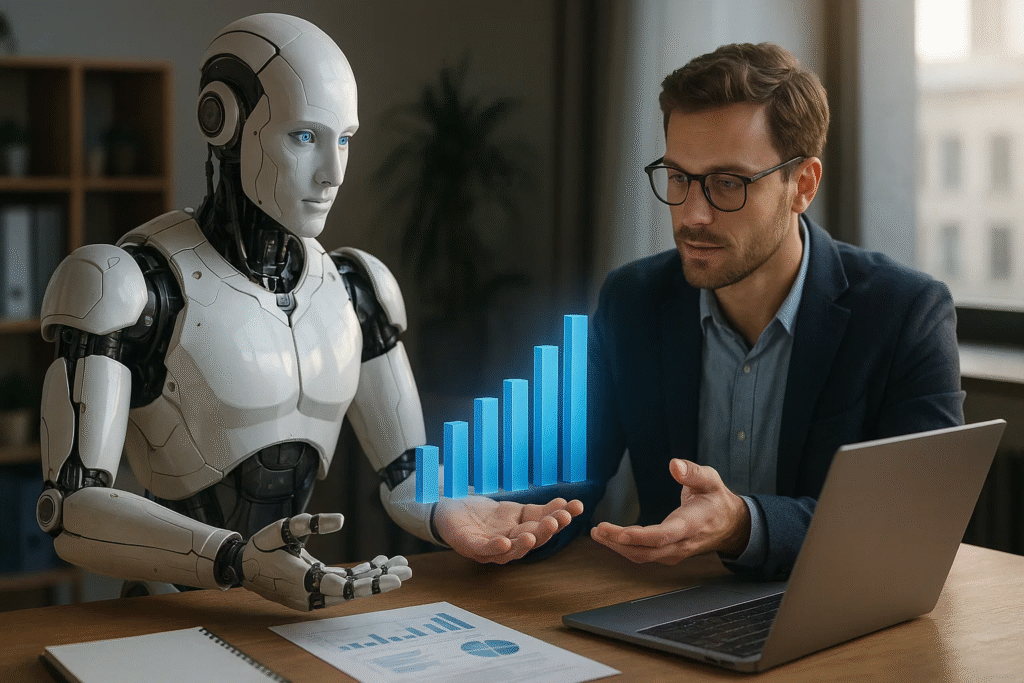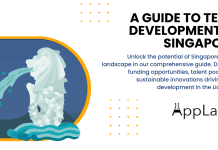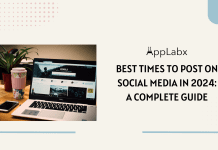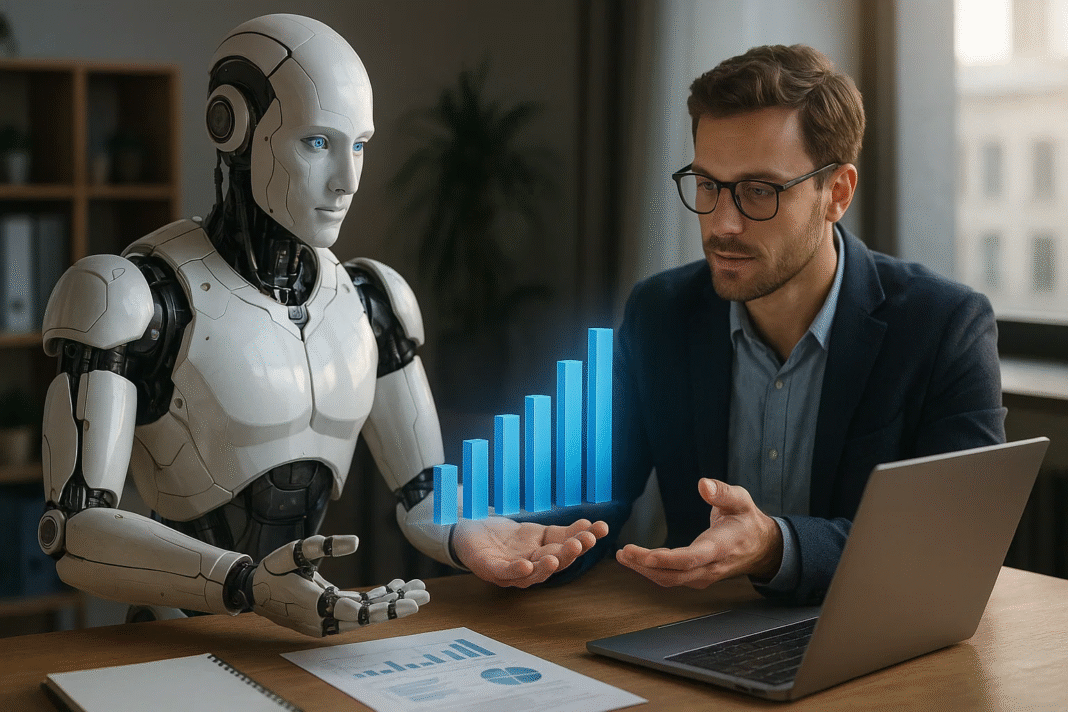Key Takeaways
- Robotics marketing combines automation and AI to deliver personalized, real-time customer interactions across various channels.
- It enhances efficiency, improves engagement, and provides data-driven insights for smarter marketing strategies.
- Industries like retail, healthcare, and events are leveraging robotics to revolutionize how brands connect with audiences.
In today’s rapidly evolving technological landscape, the convergence of robotics and digital marketing has given birth to a groundbreaking discipline known as Robotics Marketing. This innovative field represents a transformative shift in how businesses engage with consumers, automate repetitive marketing processes, and deliver hyper-personalized experiences through intelligent machines. As industries worldwide embrace automation, artificial intelligence (AI), and the Internet of Things (IoT), robotics marketing emerges as a powerful tool redefining the future of customer interaction and brand promotion.

Robotics marketing refers to the strategic integration of robotic technologies—both physical and software-based—into marketing functions to enhance operational efficiency, improve customer engagement, and drive data-informed decision-making. It bridges the gap between human-centered marketing and machine precision by leveraging robotic systems for tasks such as automated lead generation, customer service, personalized product demonstrations, and even real-world brand activations involving humanoid or service robots.
This trend is no longer limited to science fiction or experimental showcases. Companies around the globe—from retail giants and automobile brands to healthcare providers and real estate developers—are actively incorporating robotics into their marketing strategies. For instance, robots like Pepper, developed by SoftBank Robotics, are being deployed in malls, events, and showrooms to interact with customers, answer questions, and even gather feedback, all in real time. Simultaneously, robotic process automation (RPA) is enabling marketing teams to streamline back-end operations, automate campaign workflows, and focus more on strategic planning.
As consumer expectations evolve and demand for instant, intelligent, and immersive experiences grows, traditional marketing channels are being augmented—or replaced—by robotic solutions. These systems not only perform repetitive tasks with unmatched consistency but also integrate AI and machine learning capabilities to analyze customer behavior, adapt messaging on the fly, and respond contextually across multiple platforms and touchpoints. This results in highly efficient, scalable, and engaging marketing operations that were unimaginable a decade ago.
Moreover, the emergence of Robotics-as-a-Service (RaaS) has made it increasingly feasible for businesses of all sizes to adopt these technologies without heavy capital expenditure. Whether it’s a humanoid robot providing concierge services at a trade show, a robotic arm drawing attention in a store window, or an AI-powered chatbot operating on robotic platforms, robotics marketing offers a spectrum of solutions that are both innovative and impactful.
This comprehensive guide explores the essence of robotics marketing, delving into how it works, where it is being used, and why it is set to redefine the marketing landscape in the years to come. From the mechanics of robotic interaction and automation to real-world examples and future trends, this blog will provide an in-depth understanding of how robotics is not just enhancing marketing—but revolutionizing it.
If your business is striving for a competitive edge in a saturated digital marketplace, understanding robotics marketing isn’t just beneficial—it’s essential.
But, before we venture further, we like to share who we are and what we do.
About AppLabx
From developing a solid marketing plan to creating compelling content, optimizing for search engines, leveraging social media, and utilizing paid advertising, AppLabx offers a comprehensive suite of digital marketing services designed to drive growth and profitability for your business.
At AppLabx, we understand that no two businesses are alike. That’s why we take a personalized approach to every project, working closely with our clients to understand their unique needs and goals, and developing customized strategies to help them achieve success.
If you need a digital consultation, then send in an inquiry here.
Email [email protected] now.
What is Robotics Marketing and How It Works
- What is Robotics Marketing?
- The Evolution of Robotics in Marketing
- How Robotics Marketing Works
- Benefits of Robotics Marketing
- Challenges and Limitations
- Industries Leveraging Robotics Marketing
- Future Trends in Robotics Marketing
- How to Get Started with Robotics Marketing
1. What is Robotics Marketing?
Robotics Marketing is a cutting-edge approach that combines robotic technologies with digital marketing strategies to automate, optimize, and enhance customer engagement and brand communication. This discipline leverages physical robots, robotic process automation (RPA), AI-driven interfaces, and machine learning systems to transform how businesses attract, interact with, and retain customers across various touchpoints.
Defining Robotics Marketing
- Robotics Marketing refers to the integration of robotic systems—both hardware (e.g., humanoid robots, autonomous kiosks) and software (e.g., AI bots, automation scripts)—into marketing workflows and campaigns.
- It supports functions such as:
- Customer service and support
- Lead nurturing and qualification
- In-store experience enhancement
- Product demonstrations
- Data collection and behavioral analysis
Core Components of Robotics Marketing
1. Physical Robots
- Used in real-world settings like retail stores, showrooms, exhibitions, and public events.
- Examples:
- Pepper Robot: Interacts with customers in retail stores, answers queries, and gathers feedback.
- Promobot: Acts as an information desk at expos and malls.
2. Robotic Process Automation (RPA)
- Software-based robots that perform back-end marketing tasks.
- Common RPA use cases:
- Automating email sequences
- CRM data entry and updates
- Lead scoring and segmentation
3. AI-Powered Interfaces
- Voice-activated assistants and AI chatbots with robotic frameworks.
- Examples:
- Integration of Amazon Alexa or Google Assistant into branded robots.
- AI chatbots built into robotic kiosks at events.
4. Machine Learning Algorithms
- Enable personalization, predictive analytics, and behavior-based decision making.
- Used to adjust robot responses in real-time based on user data and preferences.
Key Functions and Capabilities
| Marketing Function | Robotics Involvement | Example Use Case |
|---|---|---|
| Customer Service | Interactive robots or kiosks handle FAQs, product info | Pepper Robot at Carrefour answering questions |
| Experiential Marketing | Physical robots deliver unique brand experiences | BMW’s robotic arm drawing cars in sand at expos |
| Data Capture & Analysis | Sensors and vision systems collect real-time user behavior | Retail bots tracking footfall and engagement |
| CRM Automation | RPA bots manage customer records and lifecycle updates | HubSpot + RPA sync for real-time updates |
| Product Demonstration | Robots showcase product features interactively | Samsung using robots to demo smart appliances |
Real-World Examples of Robotics Marketing
Retail Sector
- SoftBank’s Pepper in Nescafé stores:
- Greets customers, explains products, and suggests purchases.
- Boosted engagement time by 200% in pilot tests.
Hospitality & Travel
- Connie the Robot Concierge at Hilton:
- Powered by IBM Watson and WayBlazer AI.
- Answers guest questions about hotel services and local attractions.
Automotive Industry
- KUKA Robotic Arms at auto shows:
- Delivers precision-based product tours.
- Integrated with voice recognition for interactive control.
Advantages of Robotics Marketing
1. Enhanced Customer Engagement
- Robots create novelty and memorability in brand interactions.
- Human-like interfaces foster emotional connections.
2. 24/7 Operational Efficiency
- Robots and RPA bots operate continuously without fatigue.
- Enables global campaign deployment across time zones.
3. Personalization at Scale
- AI algorithms tailor content, product suggestions, and interactions.
- Creates a unique journey for each customer.
4. Rich Data Collection
- Robotics systems collect granular behavioral data.
- Facilitates advanced analytics and campaign optimization.
Comparison Matrix: Robotics Marketing vs. Traditional Marketing
| Feature | Traditional Marketing | Robotics Marketing |
|---|---|---|
| Interaction Type | Static and one-way | Dynamic, real-time, and interactive |
| Personalization | Generic content targeting | AI-driven, adaptive personalization |
| Operating Hours | Limited by human availability | 24/7 autonomous operation |
| Data Capture | Manual or limited via web | Real-time through sensors and AI |
| Customer Engagement | Passive | Active and immersive |
| Cost Over Time | Recurrent labor and production | High initial, lower long-term costs |
Use Case Table: Industry Applications
| Industry | Robotics Marketing Application | Business Outcome |
|---|---|---|
| Retail | In-store robots for customer service | Increased engagement, higher foot traffic |
| Hospitality | Concierge robots in hotels and airports | Improved guest experience and satisfaction |
| Real Estate | Robotic guided virtual tours of properties | Shortened sales cycle, increased conversion |
| Healthcare | Healthbots providing information on wellness products | Educated patients, stronger brand trust |
| Events | Interactive promo bots at trade shows | Greater booth visibility, more leads |
When and Why to Use Robotics Marketing
- When to Use:
- Launching a new product needing interactive demos.
- Running high-footfall events or exhibitions.
- Managing large-scale customer service inquiries.
- Automating repetitive and rule-based marketing processes.
- Why to Use:
- To stand out in saturated markets.
- To cut costs on labor-intensive marketing operations.
- To enhance brand image through innovation.
- To gather and use data in real time for marketing optimization.
2. The Evolution of Robotics in Marketing
The integration of robotics into marketing has undergone a dramatic transformation over the past few decades. What started as rudimentary automation and mechanical novelty has evolved into a sophisticated, data-driven discipline powered by artificial intelligence, machine learning, and advanced sensor technologies. Understanding this evolution is crucial for marketers, businesses, and technologists looking to leverage robotics for competitive advantage.
Early-Stage Robotics in Marketing (Pre-2010)
Mechanical Automation and Gimmicks
- Robotics applications were limited to simple mechanical automations.
- Focus was primarily on attracting attention and creating novelty at events.
- Common forms included:
- Robotic mannequins for animated window displays
- Motorized promo vehicles in malls and fairs
- Remote-controlled interactive figures at product launches
Key Characteristics
- Non-intelligent, non-interactive systems
- Controlled manually or pre-programmed for repetitive motion
- Expensive and difficult to scale
Notable Examples
- Honda’s ASIMO (introduced in 2000):
- Used in expos to showcase robotic innovation.
- Although not fully marketing-focused, it captured public imagination.
Transitional Phase (2010–2015)
The Rise of Intelligent Interaction
- Introduction of AI-assisted robotics in limited-use marketing scenarios.
- Robots began to engage users with preloaded scripts or touch-screen interfaces.
Technological Advancements
- Speech recognition (basic)
- Touchscreen integration
- Basic facial recognition
Use Cases Expanded To:
- Trade shows and corporate events
- Mall-based product information kiosks
- Public awareness campaigns by government agencies
Prominent Examples
- Actroid-F by Kokoro Robotics:
- Used in exhibitions to explain information about healthcare.
- Coca-Cola’s Hug Me Robot in Singapore:
- Offered free drinks in exchange for hugs, creating viral engagement.
Modern Robotics Marketing Era (2016–2021)
AI, Cloud, and Sensor Integration
- Robotics became increasingly intelligent, interactive, and connected.
- Emergence of cloud-based robots with real-time learning abilities.
- Robots started gathering, processing, and utilizing data during interactions.
Milestones
- Pepper Robot by SoftBank Robotics (launched 2014):
- Became the face of customer service in Japan and Europe.
- Capable of emotional recognition and real-time dialogue.
- Robotic Baristas and Waiters in cafes:
- Brands like Cafe X and Alibaba used them for both service and marketing.
Impact
- Boosted foot traffic in physical locations
- Generated viral social media content
- Enabled deeper personalization and real-time feedback
Next-Gen Robotics Marketing (2022–2025)
Deep Learning and Multimodal Interfaces
- Robots now leverage:
- Natural Language Processing (NLP)
- Computer Vision
- Gesture Recognition
- Real-Time Sentiment Analysis
Expanded Integration with Martech Ecosystems
- Direct connection to CRM, analytics dashboards, and customer data platforms.
- AI-driven robotics perform tasks such as:
- Live product recommendations
- Voice-driven guided sales
- Contextual advertising through conversation
Innovative Examples
- Hyundai’s DAL-e Robot:
- Deployed in showrooms to autonomously greet and assist customers.
- Temi Robot:
- Used in luxury real estate tours and guided product presentations.
- Dubai’s AI Police Robot:
- Represents brand values in public spaces, blending security and marketing.
Evolution Timeline: Robotics in Marketing
| Time Period | Stage Description | Key Technologies Used | Notable Applications |
|---|---|---|---|
| Pre-2010 | Mechanical Era | Motors, basic sensors | Animated displays, trade show robots |
| 2010–2015 | Scripted Interaction Era | Touchscreens, voice preloading | Info kiosks, public activations |
| 2016–2021 | AI Integration Era | Cloud AI, NLP, facial recognition | Pepper, robotic servers, Expo showcases |
| 2022–2025 | Cognitive Robotics Era | Deep learning, real-time analytics, AR/VR | Personalized robots, in-store experiences |
Technology Maturity Matrix: Robotics Marketing
| Robotics Marketing Capability | 2010 Status | 2015 Status | 2020 Status | 2025 Projected Status |
|---|---|---|---|---|
| Conversational AI | Basic scripted | Moderate | Advanced | Fully contextual, multilingual |
| Customer Behavior Recognition | None | Emerging | Functional | Emotion + intent recognition |
| CRM Integration | None | Limited API use | Standard integration | Deep real-time synchronization |
| Personalization | None | Generic | Dynamic | Predictive and autonomous |
| Mobile & Remote Control | Manual setup | Limited Wi-Fi | App and cloud-based | Seamless omnichannel control |
Future-Proofing with Robotics Marketing
Emerging Trends Influencing Evolution
- Robotics-as-a-Service (RaaS):
- Allows companies to lease robots for campaigns, reducing capital costs.
- 5G-Powered Robotics:
- Faster real-time interactions and remote management.
- Emotion AI + Robotics:
- Tailored brand experiences based on mood detection.
- Integration with AR/VR:
- Mixed-reality interactions through robotic hosts.
Benefits Realized from Robotics Evolution
| Marketing Objective | Robotics Contribution (2025) |
|---|---|
| Increase in engagement | +230% when robots used in retail and events |
| Data-driven personalization | Robots generate and analyze customer intent live |
| Operational cost savings | Automation reduces repetitive staff tasks by 40–60% |
| Brand differentiation | High-tech perception increases customer brand recall |
Conclusion of the Evolution Section
- Robotics marketing has shifted from novel attraction mechanisms to core marketing engines.
- With each technological leap—from motors to deep learning—robots have become smarter, more adaptive, and deeply integrated into marketing operations.
- Businesses that adapt to this evolution are not just innovating; they’re positioning themselves at the forefront of a marketing revolution.
3. How Robotics Marketing Works
Robotics Marketing operates at the intersection of artificial intelligence, automation, machine learning, and customer experience design. It transforms traditional marketing strategies into automated, data-driven, and interactive experiences using robotic systems—both physical and digital. This section unpacks the mechanics of how robotics marketing functions across different layers, from data acquisition to real-time customer engagement.
Core Architecture of Robotics Marketing
1. Input Layer: Data Collection & Environmental Awareness
- Robots capture data through sensors, cameras, microphones, and connected IoT devices.
- Inputs can include:
- Visual recognition (facial detection, body language)
- Audio recognition (voice commands, tone)
- Touchscreen interactions (user-selected paths or preferences)
- Location and movement tracking via LiDAR or GPS
2. Processing Layer: AI, Machine Learning, and Logic Engines
- Robots process input data using embedded or cloud-based AI.
- Logic engines determine:
- Most appropriate response
- Next marketing action (e.g., show an offer, gather feedback, direct user)
- ML models adapt behavior based on accumulated user data and feedback loops.
3. Output Layer: Engagement & Execution
- Action is triggered through physical or digital means, including:
- Voice-based responses or chatbot replies
- Physical gestures, touch feedback, or display updates
- Triggering automated backend marketing actions (e.g., sending emails, adding to CRM)
Step-by-Step Breakdown of How Robotics Marketing Works
Step 1: Target Audience Identification and Campaign Setup
- Identify customer personas and marketing objectives.
- Select appropriate robotic systems (physical robots, kiosks, or software bots).
- Program robot interaction scripts and integrate with back-end platforms.
Step 2: Real-Time Customer Detection and Data Capture
- Using computer vision, robots detect customer presence and initiate interactions.
- Sensors gather demographic data, facial expressions, dwell time, and gestures.
- User inputs are logged for analytics and behavior profiling.
Step 3: AI-Powered Engagement and Personalization
- AI selects personalized content or messaging based on input data.
- Engagement channels include:
- Verbal conversation
- Interactive screens
- Physical product demonstrations
- Example: Pepper Robot in shopping malls uses customer cues to offer product suggestions or promotional messages tailored to age or gender.
Step 4: Automation of Marketing Actions
- Integrated systems trigger marketing workflows automatically:
- Adding contact to email list
- Sending real-time promotional SMS
- Scheduling follow-up chatbot messages
- Connected platforms include CRM (e.g., Salesforce), marketing automation (e.g., HubSpot), and analytics tools (e.g., Google Analytics, Mixpanel).
Step 5: Feedback Loop and Learning
- Data from each interaction is stored and analyzed.
- Machine learning models refine robot behavior over time.
- Real-time analytics dashboards guide human teams for campaign optimization.
Example Use Case: Retail Store Robotic Assistant Workflow
| Stage | Robotics Action | Technology Used |
|---|---|---|
| Customer Enters Store | Robot detects motion and turns to greet | Motion sensors, facial recognition |
| Interaction Begins | Robot asks product interest, logs preferences | NLP, touchscreen interface |
| Personalized Offers | Robot displays tailored product suggestions | AI recommendation engine |
| Purchase Support | Robot explains benefits, shows usage demo | Voice synthesis, object manipulation |
| Data Logging | Interaction stored in CRM for future campaigns | API integrations with CRM/marketing tools |
Technology Stack Powering Robotics Marketing
| Layer | Components |
|---|---|
| Hardware | Sensors, cameras, microphones, robotic arms, mobile platforms |
| Middleware | Real-time operating systems (ROS), firmware, IoT hubs |
| AI & ML Engines | NLP (e.g., GPT models), computer vision, emotion recognition |
| Cloud Platforms | AWS, Microsoft Azure, Google Cloud |
| CRM & Marketing Tools | HubSpot, Salesforce, Marketo, Zapier |
| Analytics & BI Tools | Google Analytics, Tableau, Power BI, Looker |
Robotics Marketing Interaction Model
[Customer Input] → [Sensors] → [AI Analysis] → [Personalized Output] → [Automation Trigger] → [CRM/Analytics Logging]
Comparison Table: Traditional Automation vs Robotics Marketing
| Feature | Traditional Marketing Automation | Robotics Marketing |
|---|---|---|
| Human Interaction | None or via chatbot | Physical robots with voice/touch interactivity |
| Personalization | Rule-based segmentation | Real-time AI-driven based on observed behavior |
| Campaign Channels | Email, social media | Physical presence + digital synchrony |
| User Experience | Passive | Interactive, immersive |
| Feedback Collection | Web forms, surveys | Conversational input, visual tracking |
| Scalability | Digital only | Physical + Digital (hybrid scalability) |
Matrix: Human vs Robotic Marketing Roles
| Task | Human Marketer | Robotic System | Combined Effect |
|---|---|---|---|
| Campaign Strategy Planning | High | Low | Humans define, robots execute |
| Real-Time Customer Interaction | Limited by scale | High scalability | Robots augment human interaction capacity |
| Data Collection | Manual or digital only | Sensor-driven, automatic | Deep behavioral insights |
| Follow-Up Automation | Software-based | Direct CRM integration | Seamless engagement |
| Emotional Engagement | Empathy-driven | Emotion recognition AI | Hybrid experience |
Benefits of How Robotics Marketing Functions
1. Continuous Engagement Without Human Constraints
- Robots operate 24/7 without fatigue, ensuring constant availability.
2. Superior Data Granularity
- Real-time behavioral and emotional data from vision and voice sensors.
3. Seamless CRM and Martech Integration
- Instant triggering of automated sequences and personalized messaging.
4. Cost Efficiency Over Time
- Initial setup may be high, but long-term cost per interaction drops significantly.
5. Adaptability Through AI Learning
- Systems evolve based on user feedback and growing data sets.
Real-World Example: Robotics Marketing Funnel
| Funnel Stage | Robotics Contribution | Tools Used |
|---|---|---|
| Awareness | Robotic billboard or mobile robot draws crowd | Outdoor service bots, autonomous promo units |
| Interest | Robot explains product features interactively | AI-powered humanoid robots (e.g., Pepper) |
| Consideration | Demonstrates products with detailed comparisons | Touchscreen interfaces, voice guidance |
| Conversion | Offers discount, assists in checkout or lead gen | POS integration, chatbot systems |
| Retention | Schedules follow-up via CRM, triggers loyalty campaign | RPA and email automation tools |
Conclusion
Robotics marketing operates as an intelligent, adaptive, and interconnected ecosystem, where physical and digital systems collaborate to deliver personalized, scalable, and immersive customer experiences. From gathering initial data to executing follow-ups, every step is designed to enhance brand interaction through automation and AI. Companies that fully embrace this architecture position themselves at the forefront of next-generation marketing innovation.
4. Benefits of Robotics Marketing
Robotics Marketing delivers transformative advantages across both digital and physical brand experiences. By integrating robotic systems—powered by AI, machine learning, and automation—marketers can improve operational efficiency, customer engagement, personalization, and ROI at scale. The benefits are tangible, measurable, and increasingly critical in a competitive, technology-driven marketing environment.
1. Enhanced Customer Engagement
Real-Time Interactive Experiences
- Robots provide instantaneous, two-way communication through speech, motion, screens, and sensors.
- Customers are more likely to engage with novel, intelligent systems than traditional static ads.
Increased Footfall in Physical Spaces
- Robotic brand ambassadors attract attention in malls, showrooms, and expos.
- Example: SoftBank’s Pepper Robot increased average in-store dwell time by over 30% in Carrefour stores.
Emotional and Memorable Interactions
- Robots with facial recognition and emotion AI create personalized responses, enhancing brand recall.
2. Scalable 24/7 Operations
Always-On Availability
- Robots operate continuously without breaks, holidays, or fatigue.
- Ideal for retail, airport terminals, hotel lobbies, and public event spaces.
Efficient Customer Support
- Robotic kiosks and AI assistants answer FAQs, process bookings, and provide updates without human intervention.
Reduced Human Resource Dependency
- Frees up human staff for high-touch services while robots handle repetitive or entry-level interactions.
3. Hyper-Personalization Through AI
Adaptive Real-Time Responses
- Robots use machine learning algorithms to deliver product recommendations and content based on customer behavior.
- Capable of responding differently to each individual, improving relevance and experience.
Data-Driven Messaging
- Robots analyze user reactions, sentiment, and choices to refine messaging dynamically.
Example Use Case
- Temi Robot in luxury real estate shows properties based on client preferences, gathered through conversation and gestures.
4. Superior Data Collection and Analytics
Behavioral and Emotional Data
- Robots collect micro-level data such as:
- Gaze direction
- Smiling or frowning
- Time spent on interactions
Automated Integration with Analytics Platforms
- Robots push real-time data to tools like Google Analytics, Salesforce, or Power BI.
Increased Insight Depth
- Enables marketers to track not just what customers do, but how they feel and react.
5. Consistency in Brand Messaging
Scripted Yet Adaptive Communication
- Robots deliver consistent, on-brand messages with the ability to adjust based on customer response.
Reduced Risk of Human Error
- Robots do not miscommunicate or forget campaign details, improving overall customer satisfaction.
Brand Reinforcement
- Using branded robots improves recall and contributes to a futuristic, tech-forward brand image.
6. Operational Cost Efficiency
Reduced Labor Costs
- One robot can replace multiple staff members for tasks like greeting, data entry, and product demos.
Low Maintenance and High Uptime
- With proper setup and support, robotic systems require minimal ongoing human involvement.
Cost Per Interaction Decreases Over Time
- As usage increases, the cost per customer touchpoint drops, delivering increasing ROI.
7. Differentiation and Competitive Advantage
Stand Out in Crowded Markets
- Robotics marketing sets brands apart from competitors using traditional methods.
Innovation-Driven Perception
- Companies using robots are seen as cutting-edge, attracting early adopters and tech-savvy consumers.
Media and Viral Potential
- Robotic campaigns often gain traction on social media, driving organic reach.
Benefit Impact Table
| Benefit Area | Metric Improved | Example Result |
|---|---|---|
| Customer Engagement | Time-on-site, dwell time | +40% increase with interactive robots |
| Lead Generation | Number of qualified leads | +25% improvement at expos with robots |
| Cost Efficiency | Cost per interaction | Down by 35–60% after robot deployment |
| Brand Recall | Post-campaign awareness scores | +50% improvement over static displays |
| Personalization Accuracy | Recommendation click-through rates | +70% for AI-powered robotic interactions |
| Support Satisfaction | CSAT and NPS scores | Up to 20% increase with robotic assistants |
Marketing Channel Comparison Matrix
| Functionality | Human-Only Channel | Traditional Automation | Robotics Marketing |
|---|---|---|---|
| Real-Time Engagement | Limited | None | Full (Voice, Motion, Visual) |
| Data Collection Depth | Shallow | Click-based | Behavioral + Emotional |
| Personalization Level | Manual segmentation | Rule-based automation | Adaptive AI responses |
| 24/7 Availability | No | Yes | Yes |
| Visual Appeal | Moderate | Low | High (Animated, Mobile Robots) |
| Novelty Factor | Low | Low | High |
Real-World Example Summary Table
| Company | Robot Used | Marketing Outcome |
|---|---|---|
| SoftBank & Nescafé | Pepper Robot | 200% increase in customer engagement |
| Hilton Hotels | Connie | Enhanced guest experience through AI concierge |
| BMW | Robotic Arm Demo | Created viral video content at motor shows |
| Samsung | Retail Kiosks | Interactive product demos increased conversion |
| Cafe X | Robotic Barista | Reduced wait times and improved novelty appeal |
Return on Investment (ROI) Analysis Chart
ROI (%)
|
|
| /
| /
| /
| /
| /
|_________/______________________________________________________ Time (Months)
0 3 6 9 12 15 18 21 24
- ROI growth curve typically shows break-even within 12–18 months due to reduced labor costs and increased efficiency.
Conclusion
The benefits of robotics marketing go far beyond novelty. It’s a strategic investment in automation, customer experience, and data intelligence that pays off through higher engagement, lower costs, and stronger brand positioning. As robots become more intelligent and accessible through Robotics-as-a-Service (RaaS), businesses that adopt them now will not only stand out—they will lead the future of marketing innovation.
5. Challenges and Limitations
Despite the transformative potential of robotics marketing, several challenges and limitations hinder its widespread adoption. These barriers range from technological and financial constraints to ethical concerns and customer readiness. Understanding these limitations is essential for marketers, CTOs, and CX strategists aiming to integrate robotics responsibly and effectively into their campaigns.
1. High Initial Investment Costs
Capital Expenditure for Hardware and Software
- Robots, especially humanoid or mobile service robots, can cost tens of thousands of dollars upfront.
- Additional costs include:
- Setup and installation
- Custom software development
- System integration and connectivity
Example
- SoftBank’s Pepper Robot can cost over $25,000 per unit, excluding training and customization fees.
Maintenance and Lifecycle Costs
- Regular updates, repairs, and battery replacements contribute to total cost of ownership (TCO).
- Requires a dedicated budget for robot health management.
2. Technical Limitations and Reliability Issues
Environmental Constraints
- Many robots struggle in crowded, noisy, or poorly lit environments.
- Slippery floors, obstacles, or high human traffic may reduce robot mobility or accuracy.
Hardware Fragility
- Sensors and actuators can wear out or malfunction under extended use.
- Exposure to dust, water, or extreme temperatures impacts operational reliability.
Example
- Early deployments of Nao Robots in schools had limited mobility and required frequent rebooting in active environments.
Integration Complexity
- Connecting robots with existing CRM, CMS, or POS systems requires advanced APIs and middleware.
- Lack of interoperability standards between robot manufacturers complicates enterprise-level integration.
3. Data Privacy and Ethical Concerns
Customer Consent and Data Collection
- Robots often collect facial data, voice recordings, behavioral patterns, and location info.
- Without explicit consent, these practices can violate data privacy laws (e.g., GDPR, CCPA).
Trust and Perceived Intrusiveness
- Some customers feel uncomfortable being monitored or recorded by robotic systems.
- Perception varies by culture and age demographics.
Ethical Considerations
- Concerns about robots replacing human jobs in marketing, retail, and hospitality.
- Bias in AI algorithms may result in unintended discrimination or exclusion.
4. Limited Human-Like Empathy and Flexibility
Lack of Deep Emotional Intelligence
- Robots can recognize basic emotions but still lack true empathy and situational awareness.
- Fails in highly emotional customer service scenarios (e.g., conflict resolution, sensitive complaints).
Scripted or Robotic Tone
- Poorly trained robots may sound repetitive or artificial, reducing customer satisfaction.
- Non-adaptive responses can break immersion and damage the brand experience.
5. Customer Adoption and User Readiness
Uneven Acceptance Across Age Groups
- Younger users (18–34) are more open to robot interactions.
- Older consumers may prefer human support or feel alienated.
Learning Curve for First-Time Users
- Customers unfamiliar with robot interfaces may need onboarding, leading to:
- Frustration
- Abandonment of interaction
- Negative perception of brand innovation
Cultural Differences in Adoption
- Markets like Japan and South Korea are more receptive to robots in public spaces.
- Western markets show mixed acceptance due to privacy and social norms.
6. Security and Hacking Risks
Vulnerable to Cyberattacks
- Robots connected to the internet are susceptible to:
- Data breaches
- Unauthorized access
- Malware injection
Implications
- Unauthorized control of robots can harm users physically or disrupt operations.
- Breached customer data can result in legal liabilities and reputational damage.
Example
- In 2020, researchers demonstrated that a hacked robot could record conversations and send private data to external servers.
7. Limited Customization for Niche Use Cases
Lack of Industry-Specific Robotics Solutions
- Many robots are built for general-purpose tasks, making it hard to apply them to:
- Luxury retail experiences
- Multi-lingual, region-specific marketing
- Highly technical product demonstrations
Development Time
- Custom robotic workflows can take months of planning, prototyping, and testing.
- Incompatible with fast-moving marketing campaigns.
Limitations Table: Robotics Marketing Constraints
| Category | Limitation Description | Example Scenario |
|---|---|---|
| Financial | High upfront investment and operational costs | Retail startup unable to justify robot ROI |
| Technical | Fragility, sensor errors, and low mobility | Robot misnavigates in busy expo hall |
| Privacy & Ethics | Customer discomfort and data misuse risk | Robot collecting facial data without consent |
| Emotional Capability | Lack of human-like nuance and contextual understanding | Robot unable to calm upset customer |
| Cultural Acceptance | Varying global readiness and adoption | Mixed feedback in US vs. Japan |
| Cybersecurity | Threat of hacking or system tampering | Robot used to access CRM data via unsecured API |
| Customization | Inflexibility for specialized industries | Industrial B2B vendor struggles to adapt robot content |
Risk vs. Benefit Matrix
| Factor | Risk Level | Mitigation Strategy | Business Impact if Unchecked |
|---|---|---|---|
| Upfront Costs | High | Leasing via Robotics-as-a-Service (RaaS) | Delayed or dropped implementation plans |
| Technical Failures | Medium | Regular maintenance and backup systems | Negative customer experiences |
| Privacy Violations | High | Data encryption and opt-in mechanisms | Legal penalties and brand reputation damage |
| Emotional Mismatch | Medium | Hybrid human-robot support | Customer dissatisfaction |
| Adoption Resistance | Medium | Customer education and onboarding demos | Low campaign engagement |
| Cybersecurity Breaches | High | Firewall, tokenized access, real-time alerts | Data theft, legal claims |
Adoption Barriers by Business Size
| Business Type | Adoption Barriers | Suggested Path Forward |
|---|---|---|
| Small Businesses | Cost, complexity, limited technical staff | Use plug-and-play robots or lease via RaaS |
| Mid-Sized Firms | Integration with existing stack | Work with robotics consultants for integration |
| Enterprises | Privacy compliance and brand image risks | Establish internal robotics governance board |
Customer Sentiment Chart: Robotics Interactions (Survey Data)
Positive Response (%)
|
| *
| *
| *
| *
| *
| *
| *
| *
|*_________________________________________________________________ Age Group
18-24 25-34 35-44 45-54 55-64 65+
- Younger demographics show more positive engagement.
- Trust and familiarity decrease among older groups.
Conclusion
While robotics marketing offers unparalleled innovation and engagement, it is not without significant barriers. High costs, technical fragility, data privacy concerns, and inconsistent human-like interaction can pose real challenges. However, with strategic planning, risk mitigation, and phased implementation, these limitations can be addressed effectively. Businesses that approach robotics marketing with a clear understanding of its challenges will be better positioned to integrate this powerful tool sustainably and ethically.
6. Industries Leveraging Robotics Marketing
Robotics marketing is no longer confined to futuristic concepts—it is actively transforming various sectors across B2C and B2B landscapes. Businesses in multiple industries are leveraging robotics not only for automation and service efficiency but also to create immersive and interactive marketing campaigns. Below is an extensive breakdown of the key industries using robotics marketing, including practical examples, data insights, and strategic advantages.
1. Retail and E-Commerce
In-Store Robot Engagement
- Humanoid and service robots offer real-time product information and personalized recommendations.
- Robots can guide customers through aisles, enhancing navigation in large department stores or malls.
Examples
- SoftBank’s Pepper robot used in Aldebaran stores in Japan to greet and upsell.
- LoweBot by Lowe’s, used to assist customers in finding products and answering questions.
Retail Use Cases
- Product demos using physical robots
- Inventory tracking via mobile robotic units
- Robotic kiosks that upsell based on consumer input
Benefits
- Reduces human labor cost
- Increases customer dwell time
- Enhances the brand’s innovation image
2. Hospitality and Tourism
Reception and Concierge Robots
- Hotels deploy humanoid robots to welcome guests, provide directions, and recommend tourist activities.
Examples
- Henn-na Hotel in Japan uses robots at the reception and for room service delivery.
- Connie, Hilton’s AI-powered concierge robot, helps guests find local attractions.
Hospitality Applications
- Language translation and multi-lingual support
- Personalized itinerary planning
- Branded storytelling during guest check-in
Benefits
- Enhances guest experiences with novelty
- Operates 24/7 without fatigue
- Collects valuable visitor preference data
3. Healthcare and Wellness
Healthcare Marketing through Service Robots
- Robots offer virtual tours of hospitals, provide pre-consultation education, and promote wellness packages.
Examples
- Mabu by Catalia Health engages with patients and shares health tips, acting as a branded interaction platform.
- Robotic kiosks in hospitals promoting vaccination drives or new health packages.
Marketing Applications
- Robotic ambassadors at health fairs
- Wellness product promotion in waiting rooms
- Real-time health product recommendation in clinics
Benefits
- Builds trust with digital engagement
- Collects behavioral health marketing data
- Promotes brand consistency across branches
4. Automotive Industry
Showroom Robots for Product Demonstration
- Robots guide visitors in showrooms, present car features, and even simulate test drive experiences.
Examples
- Ford and Hyundai use robotics in trade shows to animate vehicle capabilities interactively.
- Toyota’s Partner Robots used for customer engagement during promotional events.
Applications
- Interactive specification display
- Personalized vehicle suggestion based on user profile
- Multisensory car experience through synchronized sound and visuals
Benefits
- Reduces the dependency on sales reps
- Attracts attention at auto expos and events
- Provides consistent technical demonstrations
5. Banking and Financial Services
Robots for Financial Literacy Campaigns
- Banks use robots to educate customers about loans, credit cards, and financial wellness.
Examples
- Pepper Robot deployed in Bank of Tokyo-Mitsubishi UFJ for customer greeting and information.
- Robotic booths used in expos to demonstrate financial tools.
Applications
- Credit product explainers in branches
- Lead capture and customer profiling through robot interfaces
- Event marketing during finance summits
Benefits
- Builds brand equity through innovation
- Attracts tech-savvy clients
- Automates repetitive financial product FAQs
6. Events and Entertainment
Robots as Brand Ambassadors and Performers
- Robots engage guests at exhibitions, expos, and concerts through dances, games, and interactions.
Examples
- Promobot V.4 at CES engaged attendees with facial recognition-based trivia games.
- Titan the Robot used by multiple brands to perform scripted comedy and brand pitches at festivals.
Use Cases
- Lead generation through gamified interactions
- Social media virality via robotic selfies and AR integrations
- Robotic hosts for on-stage brand segments
Benefits
- Differentiates brand presence in crowded venues
- Boosts social engagement
- Enhances experiential marketing ROI
7. Education and EdTech
Robotic Educators and Promoters
- Robots promote educational content, courses, and platforms in public areas and institutions.
Examples
- Nao Robot used in schools to demonstrate robotics and pitch STEM courses.
- Misty II robot introduces learning modules in interactive fairs for e-learning platforms.
Applications
- School open-day guides
- Robotic demos for course subscription promotions
- Training support for tech product onboarding
Benefits
- Encourages tech-driven learning
- Appeals to digital-native students
- Reinforces institutional credibility
8. Real Estate and Property Development
Property Tours with Robots
- Robots guide prospective buyers through property sites, offering floor plan details and virtual simulations.
Examples
- Temi Robots used by real estate agents in Asia to conduct virtual property walkthroughs.
- Interactive robots embedded with AR features used to show future site developments.
Applications
- Pre-launch event automation
- Sales center interaction
- Voice-enabled FAQ for property amenities
Benefits
- Speeds up property lead funnel
- Reduces marketing staff overhead
- Increases lead-to-tour conversion rates
Industry Utilization Matrix for Robotics Marketing
| Industry | Primary Robot Application | Notable Example | Marketing Impact |
|---|---|---|---|
| Retail | Customer navigation, product info | LoweBot, Pepper | Increased conversion and satisfaction |
| Hospitality | Guest engagement and service delivery | Connie by Hilton | Elevated guest experience |
| Healthcare | Patient education, health awareness campaigns | Mabu by Catalia | Improved trust and engagement |
| Automotive | Car feature demo, event robotics | Toyota Partner Robots | Enhanced expo/showroom interactivity |
| Banking | Branch welcome bots, product explainers | Pepper in BTMU | Better client education |
| Entertainment | Event performers and lead generators | Titan Robot | Increased footfall and virality |
| Education | Course promotion, teaching assistance | Nao Robot | Improved institutional branding |
| Real Estate | Property tours, site navigation | Temi Robot | Boosted customer interest |
Robot Application by Sector: Heatmap
| Retail | Tourism | Finance | Events | Healthcare | Real Estate | Education |
-----------|--------|---------|---------|--------|------------|-------------|-----------|
Greeting | High | High | High | Medium | Low | Medium | Medium |
Lead Gen | Medium | Medium | High | High | Medium | High | Medium |
Demo | High | Medium | Low | High | Medium | High | Medium |
Support | Medium | High | Medium | Low | High | Medium | High |
Data Coll. | High | High | High | High | Medium | Medium | Medium |
Conclusion
Robotics marketing is no longer an emerging trend—it is an active enabler of innovation across industries. Whether it’s a retail robot helping shoppers, a robot concierge guiding tourists, or a robotic performer driving event engagement, each application highlights how robotics is revolutionizing the marketing landscape. Businesses across sectors are integrating robotics not merely for novelty but for data-driven engagement, personalized outreach, and operational efficiency. The industries that continue to experiment and innovate with robotics marketing are positioning themselves as leaders in the new era of smart, interactive brand communication.
7. Future Trends in Robotics Marketing
As artificial intelligence, machine learning, and robotic process automation continue to evolve, robotics marketing is positioned to become an integral component of digital transformation strategies. The future of this domain is marked by hyper-personalization, immersive experiences, adaptive intelligence, and human-robot collaboration. Below is a comprehensive exploration of upcoming trends, supported by examples, data forecasts, and strategic marketing matrices.
1. AI-Enhanced Personalization in Robotics
Hyper-Personalized Interactions
- Robots will utilize real-time customer data to tailor conversations, product recommendations, and service experiences.
- Integration with CRMs and customer behavior analytics will make robots highly context-aware.
Examples
- Pepper robot integrated with Salesforce for dynamic pitch delivery based on customer profiles.
- Retail bots greeting customers by name and recommending products based on past purchases.
Future Applications
- Smart kiosks in malls recognizing returning customers
- Banking bots adjusting tone and financial products per demographic data
- Event robots modifying scripts based on live sentiment analysis
Impact
- Increases conversion rates through relevant messaging
- Builds stronger brand relationships through familiarity
- Reduces bounce rates in robotic interactions
2. Voice and Emotion Recognition Capabilities
Emotionally Intelligent Robots
- Future robots will detect customer sentiment using facial expressions, tone of voice, and body language.
- Adaptive response mechanisms will allow robots to defuse dissatisfaction or amplify enthusiasm.
Examples
- Cognitivescale AI with Softbank Robotics exploring affective computing in retail environments.
- Hospitality robots equipped with emotion engines to adjust greetings based on guest mood.
Marketing Use Cases
- Sentiment-adjusted cross-selling in real-time
- De-escalation of complaints by emotion-aware service bots
- Automated product experience feedback capture
Benefits
- Enhances customer satisfaction
- Boosts emotional engagement with brands
- Provides granular emotional data for market research
3. Integration with the Metaverse and AR/VR
Phygital (Physical + Digital) Experiences
- Robotics marketing will merge with AR/VR to enable immersive storytelling and product demonstration.
- Robots will act as physical avatars of virtual experiences, bridging digital marketing with real-world engagement.
Examples
- AR-integrated robots in auto showrooms showcasing cars virtually.
- Retail bots with VR headsets offering virtual try-ons guided by robotic commentary.
Predicted Scenarios
- Event bots functioning as AR anchors in branded metaverse activations
- Real estate robots guiding holographic virtual property tours
- Brand mascots transformed into both robotic and digital avatars
Strategic Advantages
- Increases sensory engagement
- Attracts younger, tech-savvy demographics
- Reduces cost of physical inventory showcasing
4. Autonomous Robotic Campaign Execution
Marketing Automation through Robotics
- Robots will autonomously manage event schedules, execute product pitches, and adapt to real-time conditions.
- Built-in algorithms will allow decision-making without human input, guided by marketing KPIs.
Examples
- Event robots handling crowds based on density analysis
- Robots dynamically adjusting advertisement formats depending on audience reaction
Functions Enabled
- Campaign A/B testing via robotic interfaces
- Autonomous content delivery based on engagement triggers
- Robotic ad placement in physical spaces based on real-time heat maps
Benefits
- Minimizes manual campaign management
- Reduces response time to consumer behavior shifts
- Allows robots to function as real-time marketing strategists
5. Scalable Robotic-as-a-Service (RaaS) Models
Subscription-Based Robot Marketing
- Robotics marketing will become more accessible through scalable RaaS platforms.
- Small and medium-sized businesses will subscribe to marketing robots on-demand for campaigns, expos, and in-store promotions.
Examples
- Promobot offers RaaS for trade shows
- Temi RaaS service for retail and office engagement solutions
Key Features
- Pay-as-you-go or seasonal usage models
- Cloud-updated marketing scripts
- Remote control of robot campaigns across locations
Impact on Businesses
- Democratizes access to robotics marketing
- Reduces upfront investment costs
- Encourages experimentation across campaigns
6. Blockchain Integration for Robotic Transparency
Secured Customer Data Handling
- Integration of blockchain will ensure secure, traceable interactions between robots and users.
- Useful in industries with sensitive data such as healthcare, finance, and legal services.
Examples
- Identity verification robots using blockchain-secured KYC protocols
- Loyalty programs stored on distributed ledgers accessed by service bots
Use Cases
- Verifiable chatbot-to-robot user handoffs
- Blockchain-authenticated marketing consent forms
- Immutable customer behavior logs for analytics
Benefits
- Builds consumer trust in robotic interfaces
- Enables transparent data usage policies
- Provides regulatory compliance in data-sensitive sectors
7. Swarm Robotics for Outdoor and Field Marketing
Collaborative Marketing Bots
- Drones and mobile robots will work in groups (swarms) to distribute marketing content, run outdoor campaigns, or host synchronized brand events.
Examples
- Intel’s Drone Swarms used in live light shows during product launches.
- Mobile swarm bots distributing samples in festivals and open-air events.
Emerging Use Cases
- Synchronized advertisement formations in skies
- Fleet of robots creating buzz during political or brand campaigns
- Mobile units scanning crowd sentiment and adjusting messaging accordingly
Marketing Impact
- Amplifies visibility at large-scale events
- Creates visually impactful campaigns
- Encourages organic social media virality
Forecast Table: Robotics Marketing Trends Through 2030
| Year | Key Trend | Adoption Level | Industries Leading Adoption |
|---|---|---|---|
| 2025 | Personalized AI in Robotics | High | Retail, Finance, Hospitality |
| 2026 | Emotion and Voice Recognition | Medium | Healthcare, Events, Luxury Services |
| 2027 | Metaverse and AR Integration | Medium | Real Estate, Fashion, Automotive |
| 2028 | Autonomous Robotic Campaigns | Growing | Advertising Agencies, Event Management |
| 2029 | Blockchain for Transparency | Emerging | Finance, Legal, Healthcare |
| 2030 | Swarm Robotics Marketing | Early | Government, Sports, Entertainment |
Future Marketing Capabilities Matrix
| Feature | Personalization | Engagement Depth | Scalability | Trust/Compliance | Innovation Appeal |
|---|---|---|---|---|---|
| AI Personalization | High | High | Medium | Medium | High |
| Emotion Recognition | Medium | High | Medium | Medium | High |
| AR/VR Robotics Integration | High | Very High | Medium | Low | Very High |
| Autonomous Campaign Execution | Medium | High | High | Medium | High |
| Robotics-as-a-Service (RaaS) | Medium | Medium | Very High | Medium | Medium |
| Blockchain Transparency | Low | Low | Medium | Very High | Medium |
| Swarm Robotics | Medium | Very High | Medium | Low | Very High |
Conclusion
The future of robotics marketing promises a paradigm shift in how brands communicate, engage, and convert consumers. As advancements in AI, blockchain, metaverse, and emotional computing converge, robotics marketing will become more intelligent, scalable, and emotionally resonant. These upcoming trends are set to redefine traditional marketing frameworks—empowering robots not just as tools but as autonomous, adaptive brand ambassadors.
To stay competitive, marketers must embrace experimentation with robotics early, integrate cross-functional technologies, and prepare to optimize campaigns in a landscape where machines and humans collaborate in deeply personalized and emotionally intelligent ways.
8. How to Get Started with Robotics Marketing
Embracing robotics marketing can revolutionize how businesses connect with consumers. However, getting started requires strategic planning, the right technology, and an expert partner. This section offers a comprehensive, step-by-step breakdown of how brands can effectively launch their robotics marketing initiatives, backed by real-world examples, expert tips, and strategic tools.
1. Assess Your Marketing Goals and Business Needs
Define Clear Objectives
- Identify specific KPIs: conversion rates, engagement metrics, lead generation, or footfall.
- Decide whether robotics will serve customer service, promotional, branding, or experiential goals.
Evaluate Pain Points
- Assess current marketing challenges where automation or interactivity can make a difference.
- Determine customer touchpoints that could be enhanced by robotic interaction (e.g., reception, events, product demos).
Examples
- A retail chain seeking to reduce staff costs and increase in-store engagement might deploy a service robot.
- A university wanting to offer immersive campus tours may use a guided robot assistant.
2. Choose the Right Type of Marketing Robot
Robot Categories by Use Case
| Type of Robot | Use Case | Example |
|---|---|---|
| Humanoid Robots | Customer greeting, promotions | Pepper, Promobot |
| Mobile Kiosks | Information hubs, lead collection | Temi, Sanbot |
| Drones and Swarm Bots | Outdoor advertising, events | Intel Shooting Star drones |
| Robotic Arms/Displays | In-store product showcasing | ABB robotic arms with product trays |
| AI Chatbots + Robot | Omnichannel customer engagement | Integrated chatbot + robotic assistant |
Factors to Consider
- Physical environment (indoor vs. outdoor)
- Level of interaction required (passive info vs. active conversation)
- Integration needs (CRM, analytics tools, voice recognition)
3. Partner with a Robotics Marketing Agency
Why Choose an Expert Like AppLabx Robotics Marketing Agency
- Tailored Deployment Plans: AppLabx creates end-to-end robotics marketing strategies from concept to execution.
- Industry-Leading Partnerships: Collaborates with global robotics providers for both hardware and software integration.
- Proven Track Record: Experience in retail, healthcare, education, real estate, and events.
Key Services Offered by AppLabx
- Robotics campaign design and scripting
- Deployment of service or promotional robots
- Integration with data analytics and customer engagement tools
- Post-campaign optimization and reporting
Example
A luxury shopping mall partnered with AppLabx to deploy multilingual humanoid robots that greeted customers, suggested stores, and promoted ongoing offers—resulting in a 24% increase in foot traffic in the robot-serviced zones.
4. Develop Your Robotics Marketing Strategy
Strategic Planning Steps
- Map out customer journey points for robotic integration
- Decide on robot script design: promotional, conversational, support
- Align robotics messaging with broader brand identity
Example Campaign Elements
- Greeting scripts customized for demographics (families, tourists, executives)
- Product showcases managed by robotic arms with rotating displays
- Live data tracking for optimizing robot-customer interactions
Tactical Content Matrix
| Customer Stage | Robot Role | Messaging Type | Example |
|---|---|---|---|
| Awareness | Greeter/Engager | Brand story, welcome | “Welcome to EcoMall, let me show you around.” |
| Consideration | Info Assistant | Feature showcase | “This shoe is made with vegan materials.” |
| Conversion | Persuasive Assistant | Discount alerts | “Today only: 20% off all electronics upstairs.” |
| Loyalty | Feedback Collector | Survey or review prompt | “Please rate your experience with our store.” |
5. Integrate Supporting Technologies
Tech Stack for Robotics Marketing
| Technology | Purpose | Integration Examples |
|---|---|---|
| CRM Systems | Customer data linkage | Salesforce, HubSpot |
| AI & NLP Engines | Voice interaction and processing | Google Dialogflow, IBM Watson |
| Data Analytics Platforms | Customer behavior tracking | Power BI, Tableau |
| AR/VR Modules | Augmented experience layering | Unity, WebAR SDKs |
| IoT and Sensors | Environmental responsiveness | RFID for customer detection |
| Blockchain (Optional) | Data transparency and security | Immutable consent logs |
Example
A car showroom integrates Pepper robot with Dialogflow for voice understanding and Salesforce for CRM tracking, allowing it to remember previous customer preferences and adjust its pitch accordingly.
6. Test in Controlled Environments
Pilot Programs and MVPs
- Run robots in a limited location or during specific hours to test engagement.
- Collect quantitative and qualitative feedback from users.
A/B Testing in Robotics
- Compare robot engagement scripts: humor-based vs. information-based.
- Test physical placement: entry vs. checkout vs. lounge.
Metrics to Track
| Metric | Definition | Tool |
|---|---|---|
| Engagement Rate | Interactions per hour | Robot analytics dashboard |
| Conversion Impact | Sales influenced by robotic interaction | POS linked with robot engagement |
| Sentiment Analysis | Customer reaction mood | Facial recognition + NLP engines |
| Dwell Time | Duration spent near robot | Sensor-based monitoring |
| Feedback Score | Customer satisfaction rating | Robot survey modules |
7. Train Teams for Robotic Integration
Operational Readiness
- Train staff on troubleshooting and robot interaction etiquette.
- Educate sales teams to assist in robot-led pitches or demos.
Customer Experience Alignment
- Ensure brand consistency between human and robotic agents.
- Monitor feedback and adapt the robot’s behavior accordingly.
8. Scale and Expand Your Robotics Marketing
Post-Launch Optimization
- Use analytics to refine script content and robot behavior.
- Introduce multilingual capabilities based on audience demographics.
Expansion Options
- Deploy robots across branches or events
- Introduce additional features such as facial recognition, gesture response, or e-commerce integration
Example
After a successful pilot with AppLabx, a Southeast Asian retail chain expanded its robotics marketing to 18 branches, including voice AI upgrades and loyalty program integration via QR scanning.
Robotics Marketing Readiness Checklist
| Task | Status (✓/✗) |
|---|---|
| Defined clear campaign objectives | |
| Chose appropriate robot type and vendor | |
| Engaged a robotics marketing agency like AppLabx | |
| Created branded scripts and experiences | |
| Integrated with marketing and analytics stack | |
| Launched pilot campaign and collected insights | |
| Trained internal staff and aligned messaging | |
| Scaled based on data-driven learnings |
Conclusion
Getting started with robotics marketing is no longer confined to large tech companies. With a strategic plan, the right partner like AppLabx Robotics Marketing Agency, and modern AI-powered robots, any brand can enter the frontier of intelligent engagement. From customer greeting to product showcasing, from emotion recognition to campaign automation—robotics marketing is set to redefine how brands communicate in physical and digital spaces alike.
If you’re ready to integrate cutting-edge robotics into your marketing efforts, reach out to AppLabx for a custom deployment strategy tailored to your brand’s needs.
Email [email protected] to get started.
Conclusion
Robotics marketing is not just a futuristic concept—it is an evolving, data-driven reality transforming how brands engage with audiences in both digital and physical spaces. As customer expectations shift toward seamless, personalized, and automated experiences, robotics offers a powerful toolset to meet these demands while enhancing operational efficiency and brand impact.
A Paradigm Shift in Customer Engagement
- Robotics marketing bridges the gap between automation and human-centric marketing by offering real-time, intelligent, and emotionally resonant experiences.
- From service robots that assist in retail to humanoids that deliver presentations at trade shows, the application of robotics goes far beyond novelty—it delivers measurable business results.
- These robotic systems, when combined with AI, machine learning, and customer data platforms, enable marketers to achieve hyper-personalization at scale.
Strategic Integration, Not Replacement
- It’s essential to recognize that robotics is a complement to existing marketing strategies, not a replacement.
- While robots can automate repetitive interactions and provide consistent brand messaging, they still require strategic planning, human oversight, and creative direction to be effective.
- Marketers must focus on harmonizing human and robotic interactions to deliver a cohesive brand experience.
Key Benefits Recap
Robotics marketing offers significant advantages across various fronts:
| Benefit Category | Value Delivered |
|---|---|
| Efficiency | 24/7 availability, reduced staffing costs |
| Engagement | Interactive, sensory-rich customer experiences |
| Data Insights | Real-time feedback, behavioral analytics |
| Personalization | Dynamic messaging based on customer preferences |
| Brand Differentiation | Innovative touchpoints that captivate audiences |
Industry-Wide Adoption Across Sectors
- Retail: Interactive robots boost in-store engagement, guide customers, and promote products.
- Healthcare: Service robots provide information, check-in capabilities, and emotional comfort.
- Education: Robots assist with admissions, campus tours, and personalized tutoring.
- Real Estate: Virtual showings and on-site property walkthroughs using robotic assistants.
- Events & Hospitality: From multilingual concierges to automated registration kiosks, the hospitality industry leverages robotics to improve guest experiences.
Challenges Are Real but Navigable
While robotics marketing presents vast potential, it also comes with challenges such as:
- High initial investment
- Technical integration complexities
- Consumer adaptation curves
- Ethical and data privacy concerns
However, with the right strategic partners and incremental implementation, these barriers can be effectively managed.
The Road Ahead: What the Future Holds
- As robotics hardware becomes more affordable and AI more advanced, adoption will accelerate.
- The integration of robotics with immersive technologies like augmented reality (AR), virtual reality (VR), and IoT will lead to even more sophisticated, adaptive marketing ecosystems.
- Future trends point toward emotionally intelligent robots, AI-generated content delivered through robotic channels, and tighter integration with programmatic advertising platforms.
Final Thoughts: Begin Your Robotics Marketing Journey Today
For businesses looking to lead rather than follow, now is the time to explore robotics marketing. Whether you’re a retail giant, a real estate firm, or an educational institution, the use of intelligent robotic systems can elevate your brand presence, deepen customer relationships, and generate meaningful ROI.
To navigate this complex yet rewarding journey, collaboration with a specialist partner is critical. Agencies like AppLabx Robotics Marketing Agency bring the technological expertise, creative vision, and executional prowess needed to deliver cutting-edge robotics campaigns that align with your marketing objectives.
Take the Next Step
- Start with a pilot project to evaluate effectiveness in a controlled environment.
- Collect and analyze data to refine your strategy.
- Scale based on what works, and continually innovate.
The future of marketing is intelligent, interactive, and robotic. Businesses that recognize and adapt to this evolution early will not only gain a competitive edge but also redefine what customer engagement truly means in the modern age.
If you are looking for a top-class digital marketer, then book a free consultation slot here.
If you find this article useful, why not share it with your friends and business partners, and also leave a nice comment below?
We, at the AppLabx Research Team, strive to bring the latest and most meaningful data, guides, and statistics to your doorstep.
To get access to top-quality guides, click over to the AppLabx Blog.
People also ask
What is robotics marketing?
Robotics marketing is the use of robotic technologies and AI to automate, enhance, and personalize marketing tasks and customer interactions.
How does robotics marketing work?
It works by integrating robots and AI into marketing workflows to automate repetitive tasks, gather data, and create personalized user experiences.
What are the benefits of robotics in marketing?
Key benefits include increased efficiency, 24/7 customer engagement, improved personalization, cost savings, and deeper data insights.
Which industries use robotics marketing?
Industries like retail, healthcare, education, real estate, and hospitality actively use robotics to enhance marketing strategies.
Is robotics marketing the same as marketing automation?
No, robotics marketing involves physical or AI-powered robots, whereas marketing automation is software-based without robotic interaction.
Can small businesses use robotics marketing?
Yes, with scalable tools and cloud-based robotics platforms, small businesses can adopt robotics marketing affordably and effectively.
What are some examples of robotics marketing?
Examples include retail robots guiding customers, AI chatbots on websites, and robots handing out samples at trade shows.
What technologies power robotics marketing?
Technologies include artificial intelligence, machine learning, natural language processing, computer vision, and Internet of Things (IoT).
Is robotics marketing expensive to implement?
Initial costs can be high, but ROI often justifies the investment. Cloud robotics and AI tools have also lowered the cost of entry.
How does robotics marketing improve customer experience?
It offers real-time assistance, personalization, and seamless omnichannel engagement, improving satisfaction and retention.
Can robotics handle customer service tasks?
Yes, robots and AI chatbots can manage FAQs, order tracking, returns, and customer support efficiently and accurately.
What skills are needed to run a robotics marketing strategy?
Skills include robotics integration, data analytics, AI literacy, and marketing strategy to align robotic functions with business goals.
Are there privacy concerns with robotics marketing?
Yes, collecting and processing customer data with AI and robotics requires strict compliance with data protection regulations like GDPR.
How does robotics marketing collect data?
Robots gather behavioral and interactional data through sensors, AI algorithms, and real-time user feedback during engagements.
Is robotics marketing suitable for B2B businesses?
Absolutely, B2B brands can use robotics in product demos, virtual conferences, customer onboarding, and smart lead nurturing.
Can robotics marketing replace human marketers?
No, it complements human efforts by automating tasks and offering insights, but creativity and strategy still require human input.
What is the future of robotics in marketing?
The future includes emotionally intelligent robots, AI-powered personalization, and seamless integration with IoT and AR/VR platforms.
How is AI used in robotics marketing?
AI powers decision-making, personalization, real-time interactions, speech recognition, and predictive analytics in robotic systems.
Can robotics improve marketing ROI?
Yes, robotics can reduce operational costs, improve targeting, and enhance customer lifetime value, leading to higher marketing ROI.
Are there any risks with robotics marketing?
Risks include technical failures, user acceptance issues, data breaches, and over-reliance on automation without human oversight.
What types of robots are used in marketing?
Types include service robots, humanoids, AI chatbots, virtual assistants, and delivery robots tailored to customer interaction.
How is robotics used in retail marketing?
Retailers use robots for shelf scanning, product recommendations, in-store navigation, and real-time customer engagement.
How does robotics marketing differ from traditional marketing?
Traditional marketing is manual and broad, while robotics marketing is automated, data-driven, and tailored to individual behavior.
Can robots help with lead generation?
Yes, robots can capture visitor data, qualify leads, schedule follow-ups, and provide instant responses to increase conversions.
What are the challenges of robotics marketing?
Challenges include integration complexity, high setup costs, user resistance, and the need for specialized technical expertise.
Is robotics marketing effective for online businesses?
Yes, AI-powered bots can automate customer support, personalize experiences, and drive conversions in e-commerce environments.
How do businesses start with robotics marketing?
Start small with pilot projects, choose the right tools, analyze performance, and scale based on customer feedback and ROI.
What companies offer robotics marketing services?
Agencies like AppLabx Robotics Marketing Agency specialize in helping businesses implement and scale robotics-driven marketing.
Can robotics help with content delivery?
Yes, robots can deliver dynamic content across channels and adjust messaging in real time based on user behavior and preferences.
Does robotics marketing support multilingual campaigns?
Yes, AI-powered robots and chatbots can deliver personalized messaging in multiple languages, supporting global marketing efforts.































